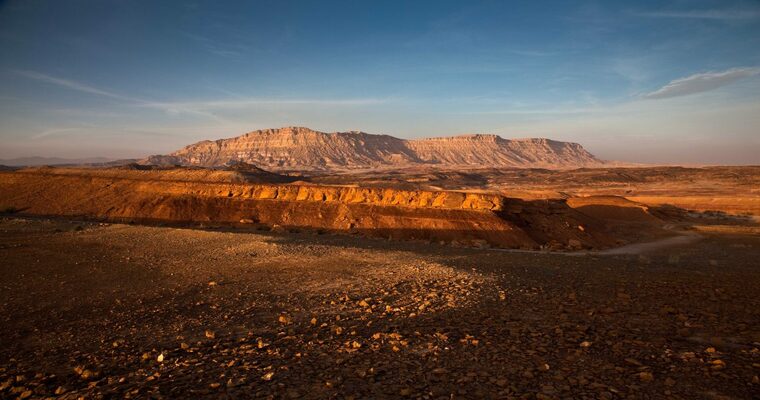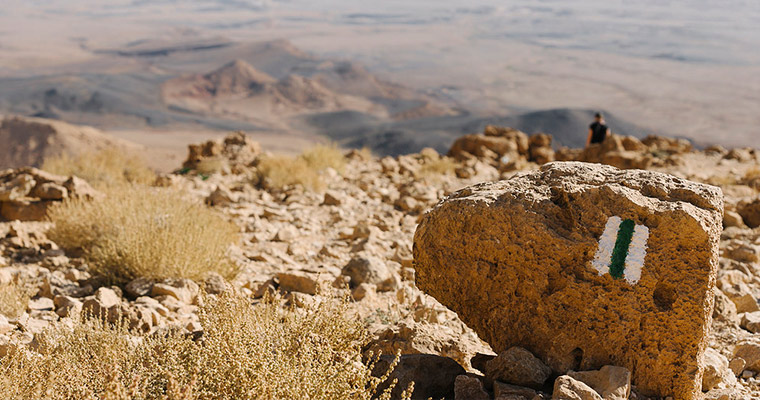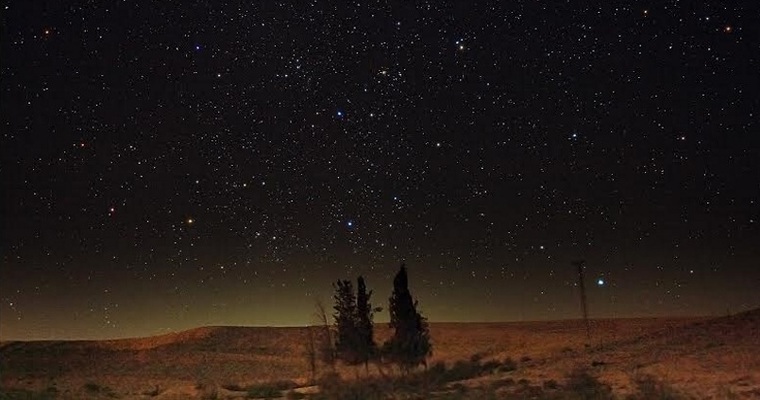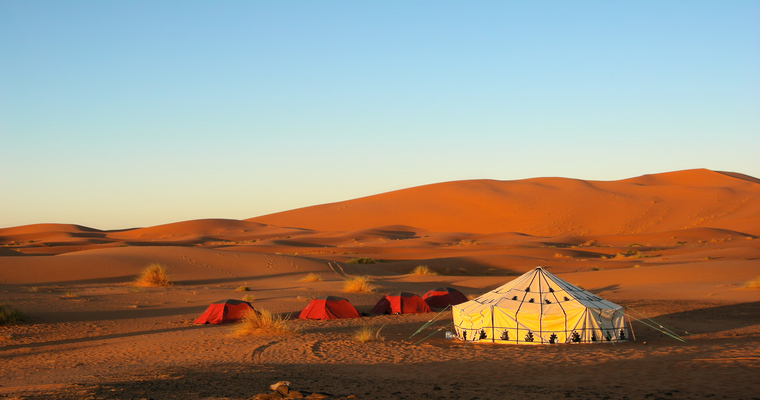The Soul of the Desert: Mitzpe Ramon
Lee Saunders 03/02/2020
The desert shatters the soul’s arrogance and is a natural extension of our own inner silence and there is nowhere more humbling or peaceful than the town of Mitzpe Ramon, in the heart of Israel’s Negev desert. Situated 2-2 ½ hours south of Tel Aviv and 2 hours north of Eilat, the area, however, never used to be so still and peaceful, as it witnessed the stunning formation of Ramon Crater over hundreds of millions of years.

Into the wild – Mitzpe Ramon. Photo credit: Doron Nissim
You could be forgiven for thinking you had landed on Mars or the set of a sci-fi movie, but you will be hypnotized by the sheer scale and size of one of the most fascinating and breathtaking sites in the country. Often described as Israel’s ‘Grand Canyon,’ this unique gigantic crater –about 14 km wide and 40 km long – was formed by erosion over hundreds of millions of years and today, you can take one of the many hiking paths and activities, such as off-road trips, rappelling, mountain biking and stargazing to appreciate the magnificent panoramic views.
Like the Ramon Crater, the sleepy town of Mitzpe Ramon took also some time to grow – although not quite as long. Founded in 1951 as a camp for workers building Highway 40, the first residents arrived in 1956 and were joined by immigrants from North Africa, Romania, and India in the 1960s, as it became one of the southernmost development towns in the Negev. Today it is home to about 5,500 people and various desert wildlife, living life at their own pace.

Markings of hiking route through Mitzpe Ramon part of Shvil Yisrael.
Whether you get to Mitzpe Ramon from Tel Aviv (around 185km), Jerusalem (around 160km) or Eilat (around 150km), the best place to start is the Ramon Crater Mitzpe Ramon Visitor Center, which tells the geological story of the formation of the Ramon Crater, the largest of five craters in the Negev desert. Learn about how these craters were created through a fascinating process of erosion, rather than meteors. Discover the incredible rock layers, unique ancient volcanic sites and water springs. At 500 meters deep, the deepest point of Saharonim Spring contains the crater’s only natural water source and sustains much of the wildlife, including onagers and ibex.
So, how was the Ramon Crater formed? Buckle tight! Briefly, long ago, during the Mesozoic era, between 66 and 250 million years ago, the central Negev desert was on the coast of the vast Tethys Sea, when suddenly – about 80 million years ago – a geological event occurred: the collision of Africa and the Eurasian continent. The result: a vast geological folding and the formation of mountains from Egypt to present-day Syria. The folds that were created were part of a system called the “Syrian Arc” and include the Negev, Judean and Galilee Hills. The highest mountain range in the Negev was submerged beneath the Tethys Sea, but its summit was exposed to long weathering processes and erosion, eventually leaving the Ramon Crater where the ancient mountain once stood.
A smaller crater was named in the early 1940s by a group of scout explorers, who gave it its name based on its resemblance to a mortar (makhtesh in Hebrew) and pestle, while in 1945, the Ramon Crater was discovered by a second group of scouts, including the late Shimon Persky, later known as Shimon Peres, one of the country’s founding fathers. In the early 1950s, mining was vital to the fledgling state so the Ramon Crater quarried minerals, such as gypsum, kaolin and other clays, but by the 1970s, it was already recognized as a natural wonder and phenomenal tourist attraction.

A night under the stars.
From Mitzpe Ramon, the view is nothing short of spectacular. Starting from the Mitzpe Ramon Visitor’s Center and continuing along the edge of Ramon Crater, the Albert Promenade is a trail with one of the best views of the crater. The paved trail is fairly accessible and connects to a path leading to the Har Gamal observation deck, one of the best places to watch the sunrise or set. This is great for those who love a hike, it is just a short walk away from descending ibex trails that lead to the bottom of the crater. Here, you can see these wild goats often descending the vertical rock face with embarrassing ease.
If you prefer, there are many jeep tours offered, including Deep Desert Israel, whose guides’ love of nature and the desert climate make the tour fascinating. With a network of hikes ranging from easy loops to advanced mountain scales with extreme passageways, this worldwide landmark is the perfect place for thrill-seekers to get their adrenaline fix. Be sure to catch the unbeatable sunset at the camel lookout or camp out under the stars. In fact, to look at the stars, there is nowhere better. In 2017, the American International Dark Sky Association declared the Ramon Crater to be an international “Dark Sky Park” – the first site in the Middle East to be bestowed with this honor, where conditions for planetary gazing are close to ideal most of the year.
The chilled vibe is present at Me’ever, a creative hub in Mitzpe Ramon, offering more than 30 yoga workshops and meditations, as well as festivals throughout the year. Located between Mitzpe Ramon and Sde Boker, Khan Hashayarot offers a Bedouin-Esque desert experience. Here you will find all the activities associated with a Bedouin stay, including camel rides, dinner eaten on cushions, bonfires, an introduction to the Bedouin life, storytelling, and tent sleeping.

Bedouin camp in the middle of Mitzpe Ramon.
To the north of Mitzpe Ramon, in the Ramat Hanegev region, is the famous kibbutz of Sde Boker and the museum dedicated to the life of Israel’s first Prime Minister, David Ben Gurion. You can take the Negev Highlands Trail, just north of here down to Mitzpe Ramon. To the west of Mitzpe Ramon is the Alpaca Farm, one of Israel’s most impressive wildlife successes, bringing South American animals to survive and thrive in the desert. Don’t miss out on getting up close and personal with alpacas and lamas and grab the chance to feed them. As a unique environment, the Ramon Crater is a unique habitat for wildlife. Take a guided tour with Bio Ramon, a pocket-sized wildlife park run by the Israel Nature and Parks Authority, which offers an exciting peek at the rare and shy creatures – some 40 species of small desert creatures, as well as snakes, rodents, porcupines, lizards, scorpions and turtles.
While the birthplace of Jazz music may seem like a million miles away in New Orleans, the Mitzpe Ramon Jazz Club has weekly entertainment, and in December it hosts lectures, concerts and jam sessions in the middle of a stunning landscape, and be sure to drive 5 minutes to the fabulous Vegan Express, delicious Mauna restaurant and Hahavit, a first-rate and affordable pub in the area for great food.
There’s something deeply fulfilling and magical about slipping away to a town offering all you could ever need to relax, reflect, and recharge.
Mitzpe Ramon: How to get there? Aside from renting a car, a family-friendly option, you can also reach Mitzpe Ramon on two buses from Tel Aviv and Jerusalem, changing in Beer Sheva, and one direct bus (392) from Eilat. Visit here for more details.
